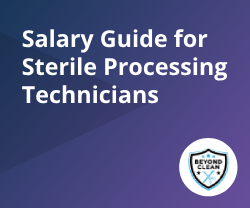Sterile processing technicians should be worth their weight in gold for all the safety and sanitization responsibilities that fall under their purview, but the reality is that every position comes with a salary range.
Your search might have brought you here after seeing a wide range of compensation data across the internet.
We know; we’ve seen it too.
However, we aim to give you the most realistic yet optimistic range of what a sterile processing technician makes annually and by the hour.
Our research includes sourced data for every statistic we provide, plus insider tips on salary negotiations and how to plan for increases down the road.
What Is the Average Salary for a Sterile Processing Technician?
To get our data, we’re using the Bureau of Labor Statistics (BLS) and the Salary.com website.
BLS Sterile Processing Tech Data
The BLS puts sterile processing technicians into the job title for Medical Equipment Preparers.
The most recent data as of this publication is from May 2023.
The average pay nationwide was $47,710, or $22.79 an hour.
Keep in mind that those numbers summarize all positions, from entry-level to expert.
BLS reports the lowest wage range was $34,020 annually or $16.36 an hour.
Only in the top 90% were wages above $30 an hour, with an annual salary of $63,980.
Salary.com Sterile Processing Technician Salary Data
When we look at Salary.com, the lowest 10% of sterile processing technicians make around $31,630, or $15.20 an hour.
The median salary nationwide on Salary.com is $19 an hour or $39,640 annually.
The highest tier comes in at $49,268 annually, or $23.69 an hour.
Salary Information by State
| State | Employed | Avg. Annual Salary | Avg. Hourly Pay | Top 10% Annual Salary | Bottom 10% Annual Salary |
|---|---|---|---|---|---|
| Alabama | 870 | $33,910 | $16.30 | $42,400 | $24,230 |
| Alaska | 150 | $55,000 | $26.44 | $76,080 | $41,650 |
| Arizona | 1,560 | $44,720 | $21.50 | $55,070 | $33,720 |
| Arkansas | 450 | $36,160 | $17.39 | $40,730 | $31,220 |
| California | 7,750 | $61,780 | $29.70 | $87,090 | $37,610 |
| Colorado | 1,190 | $50,710 | $24.38 | $64,230 | $38,040 |
| Connecticut | 820 | $49,090 | $23.60 | $61,520 | $37,490 |
| Delaware | 240 | $52,450 | $25.22 | $63,360 | $43,750 |
| District of Columbia | 210 | $58,830 | $28.28 | $86,630 | $42,880 |
| Florida | 3,570 | $42,190 | $20.28 | $53,570 | $31,750 |
| Georgia | 1,660 | $44,650 | $21.47 | $60,450 | $30,460 |
| Hawaii | 310 | $51,130 | $24.58 | $61,120 | $29,350 |
| Idaho | 480 | $43,890 | $21.10 | $65,600 | $29,050 |
| Illinois | 2,110 | $46,470 | $22.34 | $57,690 | $36,070 |
| Indiana | 1,740 | $42,250 | $20.31 | $55,710 | $32,310 |
| Iowa | 620 | $40,500 | $19.47 | $51,100 | $34,820 |
| Kansas | 650 | $40,620 | $19.53 | $52,270 | $27,500 |
| Kentucky | 960 | $42,740 | $20.55 | $57,190 | $31,730 |
| Louisiana | 370 | $38,000 | $18.27 | $46,150 | $28,880 |
| Maine | 470 | $44,740 | $21.51 | $53,760 | $35,560 |
| Maryland | 1,390 | $50,480 | $24.27 | $61,750 | $36,100 |
| Massachusetts | 1,700 | $52,070 | $25.03 | $69,830 | $37,450 |
| Michigan | 2,420 | $43,870 | $21.09 | $53,560 | $35,960 |
| Minnesota | 1,360 | $47,920 | $23.04 | $58,400 | $37,030 |
| Mississippi | 290 | $34,380 | $16.53 | $45,230 | $26,120 |
| Missouri | 1,880 | $42,580 | $20.47 | $51,550 | $34,210 |
| Montana | 280 | $43,020 | $20.68 | $57,430 | $31,730 |
| Nebraska | 590 | $40,390 | $19.42 | $53,510 | $33,700 |
| Nevada | 400 | $43,980 | $21.15 | $59,290 | $29,730 |
| New Hampshire | 470 | $47,390 | $22.79 | $57,720 | $36,800 |
| New Jersey | 2,270 | $52,480 | $25.23 | $63,510 | $40,490 |
| New Mexico | 200 | $40,470 | $19.46 | $51,960 | $26,890 |
| New York | 4,740 | $51,290 | $24.66 | $64,760 | $38,070 |
| North Carolina | 2,480 | $42,000 | $20.19 | $52,370 | $32,490 |
| North Dakota | 200 | $42,070 | $20.23 | $56,830 | $34,150 |
| Ohio | 2,630 | $42,340 | $20.36 | $54,320 | $32,180 |
| Oklahoma | 640 | $40,810 | $19.62 | $52,930 | $30,670 |
| Oregon | 1,130 | $50,820 | $24.43 | $63,680 | $38,320 |
| Pennsylvania | 2,530 | $45,330 | $21.79 | $56,580 | $36,320 |
| Rhode Island | 240 | $50,750 | $24.40 | $64,100 | $39,560 |
| South Carolina | 1,320 | $41,240 | $19.83 | $52,820 | $29,400 |
| South Dakota | 340 | $40,760 | $19.60 | $55,990 | $32,710 |
| Tennessee | 1,160 | $40,330 | $19.39 | $54,350 | $29,370 |
| Texas | 3,750 | $45,870 | $22.05 | $60,010 | $34,490 |
| Utah | 630 | $44,910 | $21.59 | $59,730 | $36,980 |
| Vermont | 120 | $44,790 | $21.53 | $56,370 | $36,530 |
| Virginia | 1,870 | $45,130 | $21.70 | $56,960 | $36,330 |
| Washington | 1,840 | $51,820 | $24.91 | $71,800 | $35,770 |
| West Virginia | 450 | $40,750 | $19.59 | $50,040 | $30,280 |
| Wisconsin | 1,210 | $45,110 | $21.69 | $55,400 | $36,100 |
| Wyoming | 100 | $45,600 | $21.92 | $57,720 | $35,090 |
| Guam | 50 | $42,440 | $20.41 | $76,110 | $22,760 |
| Puerto Rico | 130 | $26,760 | $12.86 | $34,130 | $18,870 |
Annual Average Salary: Top 10 States
The top earning state in the field is California, where the average salary is $61,780.
These are the top 10 earning states in the field:
* Employment conditions in your area may vary.
What States Pay the Most for a Sterile Processing Tech?
I’ve spent a lot of time on this data, and I can tell you that the highest wages are generally in states with higher costs of living.
The top-paying states for sterile processing technicians are California ($61,780), the District of Columbia ($58,830), Alaska ($55,000), New Jersey ($52,480), and Delaware ($52,450).
It is worth noting that Alaska, California, and New Jersey all rank in the top six states with the highest cost of living.
For example, the cost of living in California is $53,171.
Highest Paying Cities for Sterile Processing Technicians
Much like we saw with higher salaries in line with the higher cost of living, the 10 highest paying cities are in California.
The first three cover the Bay Area, from San Francisco to Fairfield, with an annual salary between $76,030 to $78,260.
It is worth noting that San Francisco’s “comfortable living” salary sits at around $131,000.
Then, the list spans out to Sacramento, Napa, and Modesto.
The popular coastal retreat of San Luis Obispo and Paso Robles is next, with Stockton, Santa Cruz, and San Diego rounding out the top 10.
Those cities all have salary ranges in the $60,000s.
What Are the Top Paying Industries for Medical Equipment Preparers?
Since cleaning and sterilizing equipment covers a broad range of healthcare settings, we can also look at the salary data on the niche elements of healthcare.
The highest-paying industries within sterile processing include:
- Company and Enterprise Management
- Consulting Services for Management, Scientific, and Technical
- Local Governments
- Specialty (Substance abuse, Psychiatry)
- Outpatient Care Centers
While the first two are reserved for those with proper manager certification and leadership skills, the average annual salary for the last three is between $53,890 and $56,910.
How to Make More Money as a Sterile Processing Technician
If you’re looking to increase your earning potential as a sterile processing technician, there are several strategies you can consider.
First, understand that entry-level or assistant positions will pay the lowest.
However, you might get the value of an employer paying for your education or certification in sterile processing.
Starting a job with a certification already in progress or obtained will improve your chances of landing at the higher end of the salary range.
Then, you can look at the advanced certifications available, like ambulatory surgery, leadership, or endoscopy.
The biggest challenge with being a sterile processing technician is that the salary range eventually hits a wall.
Unless you’re ready to move on to a job as a surgery tech or manager, you’ll be capped at the high end of the salary range.
Did You Know? Salary Secrets
It’s worth mentioning that several states, like California, Colorado, and New Jersey, require employers to list a salary range on job listings.
That at least helps you keep from guessing how much the pay will be.
Also, consider which states don’t have a state income tax, which could keep around 5% of your salary from being withheld.
States without a state income tax include Nevada, Washington, Texas, Tennessee, Alaska, South Dakota, Florida, New Hampshire, and Wyoming.
Also, traveling sterile processing technicians can make anywhere from $25 to $50 an hour with a travel stipend, but those are among the most prized roles and will require at least 1–2 years of experience.
Frequently Asked Questions
What else comes with compensation for a sterile processing technician aside from salary?
Beyond the salary for a sterile processing technician, you want to explore the full benefits package.
Even if you’re under 25 years of age and on your parent’s insurance, aging out of that benefit comes around soon enough.
It helps to know what kind of healthcare coverage your employer offers.
Ideally, you’ll get medical, vision, and dental coverage.
Look for employers who offer tiers of coverage that can accommodate your budget and healthcare needs.
Ask about coverage for your partner or children, too.
Other benefits include 401K matching, flex spending accounts, or free uniform and personal protective equipment coverage.
What states pay the lowest average salary for a sterile processing technician?
We can look at the BLS infographics for that information.
The lowest mean wage falls between $26,760 and $40,810 a year.
That’s from $12.87 to $19.62 an hour.
The states that fall into those parameters are Alabama, Arkansas, Iowa, Kansas, Louisiana, Mississippi, Nebraska, New Mexico, Oklahoma, South Dakota, Tennessee, and West Virginia.
Alabama has the lowest mean salary for a sterile processing technician, with an annual salary of $33,910.
That comes to $16.30 an hour.
Is a sterile processing technician an hourly or salaried job?
Most positions as sterile processing technicians will be paid by the hour.
That means overtime could increase the salary in a given year.
However, never accept a job based on the expectations of overtime, as it’s never guaranteed.
To figure out the annual salary of an hourly wage, multiply the hourly number by 2080 since there are 2,080 hours in a full year of 40-hour work weeks.
Example: A position pays $18.00 an hour. 18 X 2080 = $37,740.
Likewise, if you divide a salary by 2080, you’ll get the hourly wage equivalent.
This page is also available in Spanish.






